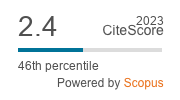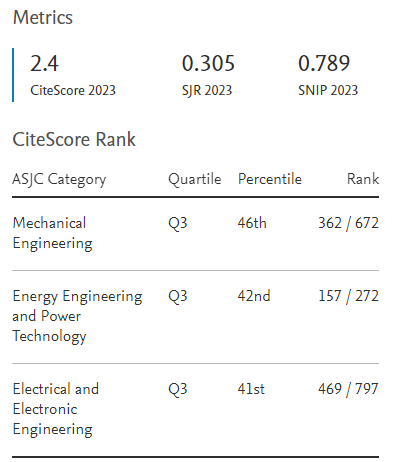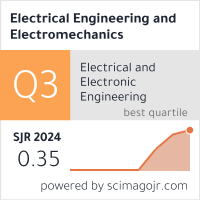MAGNETIC-PULSE PRESSING OF ELECTRICAL CONNECTIONS FOR STRANDED WIRES
DOI:
https://doi.org/10.20998/2074-272X.2019.1.09Keywords:
magnetic-pulse assembly, connection of stranded wires, numerical simulation, electrical testsAbstract
Purpose. The research of the process peculiarities of magnetic- pulse fitting of electric stranded conductor joints, made of different materials, using couplings. Evaluation of loading optimal parameters, providing high operational reliability of electric connecting units. Methodology. In order to carry out simulation and research of the process of magnetic-pulse fitting of electric stranded conductor joints CRUG24 software package was used, which was developed to estimate impact interaction. Handling the problem was carried out numerically using finite differences. Metallographic study of collected cross-sectional cuts was performed with the use of optical microscope МЕТАМ ЛВ-71, equipped with digital-still camera, connected to the computer, which used image analysis system IMEGE Expert Pro3. The electrical tests of wire joints were carried out using the thermal bench from exposure to two factors: heating with rated current and expansion by operating load. Results. It was ascertained that magnetic-pulse pressing of electric joints was followed by partial self-purification and bedding component contacting surfaces of electric joints. Oxides and contaminating impurities were expelled into small localized zones between wires, between a wire and a coupling, which resulted in the contact of juvenile surfaces. Upon mutual deformation and displacement of metal wire surface capacity size and coupling tight mechanical contact was created, which provided minimal transient resistivity. The existence of residual compression stress provides the longstanding high-quality electric contact in joints. While using magnetic-pulse pressing of electric joints, due to high speed of deformation and impact of great inertial forces, deformation containment of connected components takes place in the zone of load action. The wires in contact with each other and with couplings generate faceting, but coupling sidewall hardly has any thinning. Filled density of cross-section is approximately 100 %. This fact provides a high degree of sealing capacity of joints, which to a wide extent prevents the oxidation of contacting surfaces and the rise of transient resistivity of electric joints in the operational process. As a result of processing of the results of thermal and electrical tests it was ascertained that pressed joint factors of defectiveness with all types of wires according to thermal impact and resistivity, are significantly lower than unity. Practical value. Magnetic-pulse pressing of unattended joints in electric stranded monometallic, bimetallic and composite conductors provides high operational reliability of connecting units and it may be used while mounting overhead system of railways, transmission lines and fitting connecting components of electrical transport electric circuits.References
1. Galkin A.S., Mitrofanov A.N., Mitrofanov S.A. Matematicheskoe modelirovanie i informatsionnye tekhnologii v zadachakh diagnostiki kontaktnoi seti elektrifitsirovannykh zheleznykh dorog [Mathematical modeling and information technologies in diagnostics of the contact network of electrified railways]. Ekaterinburg, Ural State University of Railway Transport Publ., 2012. 226 p. (Rus).
2. Dmitriev V.V., Lifshits Iu.Ia., Rozin V.I. Magnetic-pulse processing of electrical engineering parts. Forging and Stamping Production, 1984, no.7, pp. 8-9. (Rus).
3. Kurlaev N.V., Gulidov A.I, Iudaev V.B. Numerical simulation of the process of assembly of the tips with electric clamps with the pressure of a pulsed magnetic field. Forging and Stamping Production. Material Working by Pressure, 2001, no.8, pp. 38-42. (Rus).
4. Kurlayev N., Gulidov A., Ryngach N., Mishukov A. Computer simulation of aircraft wires tips compression by pulse magnetic field. 5th Korea-Russia International Symposium on Science and Technology. Proceedings. KORUS 2001, vol., pp. 36-39 (Cat. No.01EX478). doi: 10.1109/korus.2001.975047.
5. Belyj I.V., Fertik S.M., Khimenko L.T. Spravochnik po magnitno-impulsnoj obrabotke metallov [Directory of magnetic-pulse treatment of metals]. Kharkiv, Vishcha shkola Publ., 1977, 189 p. (Rus).
6. Fomin V.M., Gulidov A.I., Sapozhnikov G.A. Vysokoskorostnoe vzaimodeistvie tel [High-speed interaction of bodies]. Novosibirsk, Siberian Branch Russian Academy of Sciences Publ., 1999. 600 p. (Rus).
7. GOST 12393-77. Armatura kontaktnoi seti dlia elektrifitsirovannykh zheleznykh dorog. Obshchie tekhnicheskie usloviia [State Standard 12393-77. Armature of the contact network for electrified railways. General specifications]. Moscow, Standartinform Publ., 2004. 26 p. (Rus).
8. Pravila ustroistva i tekhnicheskoi ekspluatatsii kontaktnoi seti elektrifitsirovannykh zheleznykh dorog (TsE-868) [Rules of the device and technical operation of the contact network of electrified railways]. Department of Electrification and Electricity of the Ministry of Railways of the Russian Federation. Moscow, Transizdat Publ., 2002. 184 p. (Rus).
9. Samokhvalov V.N., Grigor'ev V.L., Samokhvalova Zh.V. Ustroistvo dlia soedineniia mnogoprovolochnykh provodov [Device for connecting stranded wires]. Patent Russian Federation, no. 53819, 2006. (Rus).
Downloads
Published
How to Cite
Issue
Section
License
Copyright (c) 2019 Zh. V. Samokhvalova, V. N. Samokhvalov

This work is licensed under a Creative Commons Attribution-NonCommercial 4.0 International License.
Authors who publish with this journal agree to the following terms:
1. Authors retain copyright and grant the journal right of first publication with the work simultaneously licensed under a Creative Commons Attribution License that allows others to share the work with an acknowledgement of the work's authorship and initial publication in this journal.
2. Authors are able to enter into separate, additional contractual arrangements for the non-exclusive distribution of the journal's published version of the work (e.g., post it to an institutional repository or publish it in a book), with an acknowledgement of its initial publication in this journal.
3. Authors are permitted and encouraged to post their work online (e.g., in institutional repositories or on their website) prior to and during the submission process, as it can lead to productive exchanges, as well as earlier and greater citation of published work.





